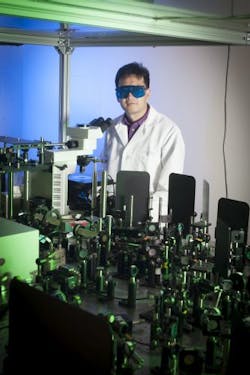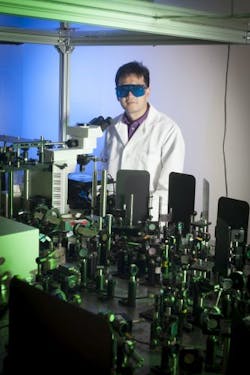In vivo spectroscopy technique could advance medical diagnostics and research
A team of researchers at Purdue University (West Lafayette, IN) has demonstrated that an in vivospectroscopy technique can reveal the chemical composition of living tissue for medical diagnostics and cellular studies.
Related: Microsecond Raman spectroscopy tool has potential in medical diagnostics
The development is potentially important because knowing the chemical content of tissue is needed for early detection of disease, and the system also can be used to study molecular dynamics in living cells as they are occurring, according to Ji-Xin Cheng, a professor in Purdue's Weldon School of Biomedical Engineering and Department of Chemistry and Scientific Director of the Label-free Imaging lab at Purdue's Discovery Park. Conventional imaging technologies such as magnetic resonance imaging (MRI) and computed tomography (CT) do not reveal the chemical composition of tissues, he says.
Although optical spectroscopy has been routinely used to study molecules in a sample cell, it is currently not practical to perform in vivo spectroscopy, or the analysis of how light interacts with molecules in living tissue. This is because photons strongly scatter when light shines through tissues, making detection of the signal through a spectrometer inefficient, Cheng says.
The new technique works by "coding" individual photons from a pulsing laser with a megahertz radio frequency and then collecting those photons with a detector after they have interacted with tissue. The system was demonstrated in human breast cancer detection. Ordinarily, the cancer tissue samples would have to be processed for histological examination, which could take up to a week. The new technology yields results in about 2 s.
The technique also was used to map vitamin E in the skin of laboratory mice. "People use vitamin E on their skin as a topical treatment, and, like any drug, we would like to know where it goes after it is applied to study drug delivery mechanisms," Cheng says. "We converted Raman spectroscopy, which is generally used to study molecules in solutions or fixed tissues, to an in vivo imaging platform that is able to monitor how a living cell executes its functions in real time. It's a proof of concept. The approach allows us to get a spectrum of individual molecules, revealing the chemical composition of the tissues."
The innovation offers "label-free" detection, or imaging that does not require the use of fluorescent dyes or other preparations to detect structures and features. Because processing kills the tissue and is time-consuming, Cheng says, the label-free technology allows the study of unaltered living tissues and cells, making for more rapid and accurate studies.
The work is ongoing, with future research exploring development of an "imaging pen" to quickly analyze surfaces for traces of explosives for homeland security applications and to monitor human tissue for disease and infection and to help surgeons determine whether any diseased tissue remains after cancer surgery, Cheng says.
Full details of the work appear in the journal Science Advances; for more information, please visit http://dx.doi.org/10.1126/sciadv.1500738.
Follow us on Twitter, 'like' us on Facebook, connect with us on Google+, and join our group on LinkedIn

